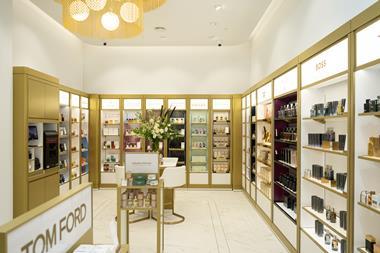Selling a single commodity from a large area sounds tricky, but Levi’s new store on Regent Street does it with a flourish.
One of the more difficult challenges that a retailer might face is how to take a single item, spread it over a very large space and maintain interest in it over repeat visits. This is the problem that faces every retailer trying to get shoppers to part with money for jeans.
In essence, give or take a couple of ounces in the weight of the base fabric, the raw material is remarkably similar and there is a tendency for it to be blue, meaning that a floor filled with the stuff runs the danger of looking remarkably boring. This is probably why most retailers have a tendency to mix other products in when creating a “denim shop”. It is really a matter of making the dull more interesting, or at least trying to do so.
And in most instances, it is interesting how relatively little of the offer is actually denim. The default method of display is the “denim wall”, where jeans are neatly folded in sized boxes, and then to arrange the non-jean merchandise in front of this, almost like an introduction.
Brave therefore to take a two-floor 8,500 sq ft store and make denim the star, with what little other merchandise there is playing a distinctly secondary role. The store in question is Levi’s and the location is Regent Street.
One stock shop
This is not a new store. The last major refurbishment of the space was in 1994, followed by what Jeff Kindleysides, of consultancy Checkland Kindleysides, describes as an “evolution” of the concept in 2000. Practically, this means that the store has not had a makeover for more than a decade and fashions change in denim and associated merchandise, as much as anywhere else in retail.
And in store design and fit-out terms, what has been done to the Levi’s store on Regent Street is more revolution than evolution. The revamp has taken 12 weeks and has involved remodelling everything from the floors, to putting a shiny glass and chrome lift into the shop.
But it is at the beginning of the store journey that shoppers will notice the difference from what was there before. Look through the windows of this shop and it doesn’t look like a jean shop. Instead, the visitor is confronted by what appears to be a photo-portrait gallery.
These framed pictures are in fact pictures of people associated with craft: artists, a film director, a set maker, a cake-baker, you get the idea - all of whom will be helping in the new
store in one form or another. Kindleysides says that it is about providing an introduction to the store, before the business of looking round the store proper is undertaken.
And to emphasise the discrete nature of this initial space, it is walled off by duck-egg blue wooden barn doors, constructed “authentically”, according to Kindleysides using a word that crops up again and again when talking about the store. The striving for authenticity is evident in the rest of this semi-gallery space, where exposed London brick has been used to create the walls and overhead there are white wooden rafters with industrial-looking metal linkages.
In total, it is a white box, but with the harsh modernity usually associated with the term taken out and replaced by a friendly ambience. This may be why Andrea Moore, marketing director at Levi’s in the UK, keeps pressing the “original and definitive” message - which she says was the underlying brief originally given to Checkland Kindleysides close to two years ago.
Pass through the wooden door that provides ingress to the rest of the store and you enter a different world. This is a relatively dark space, that has been lit, rather than being intrinsically light. There is no natural daylight and therefore it takes a moment to get your bearings. But the effect is dramatic and authentic, to use the Kindleysides mantra.
The ground floor is big and as you glance around, two things are apparent: space and industrial workshop-style grey. The floor is large, smooth and grey and stretches away into the distance, mirroring the relatively severe grey ceiling, pillars and metal-shaded pendant lights, which are reclaimed.
Kindleysides says this is about integrity and making visitors feel that they are getting in touch with the brand’s roots. Translated, this means that there is enormous attention to detail. There are, for instance, steel pallets, used as the bases for displays, which can be moved around by the kind of mini-hydraulic lift normally seen on factory floors. Then there are the mid-floor pieces of equipment, which have been treated with cream stove enamel and have wired Georgian glass for their shelves. Once again, the workshop sense is hard to escape.
Come back brighter
There are brighter areas and along the side wall there is a brightly lit white space against which white mannequin torsos have been placed, wearing blue denim tops. There is also one of the few graphics in this large shop, which is noteworthy for the fact that the stock, rather than pictures, is made to do most of the visual merchandising legwork.
Both the fitting rooms and the cash desk are also worth spending a little time admiring. The cash desk has been created from solid planks of smooth-grained wood and behind it there is more wired glass, which just allows views into the communal area of the fitting rooms. The latter have authentic stamped all over them, whether it is the “duck canvas” (a fabric used in the first Levi’s jeans) that has been used to line their walls, or the storm lights, activated by a factory machine-style red button in each cubicle, to attract the attention of staff.
Even the tokens that you are given as you make your way into the fitting rooms, with the number of garments, have been individually fashioned from stamped steel instead of the more usual plastic.
The basement, which can be reached either by the new lift or the glass and steel staircase, is larger than the ground floor. Moore says that there is about 25% to 30% more space in this store than before the refit and that this has come from rearranging the shelves and fixturing, rather than expanding the store’s envelope.
The major design features on this floor are obvious. At one end, there is a 501 jeans stockroom, where the back wall has been mirrored to make it look twice the size it actually is and the wall separating it from the sales floor is made of glass, to impart a warehouse feel. Beyond this, there is a free-standing bespoke metal rack into which pairs of jeans have been dropped.
Kindleysides says these are the most popular styles and washes, and the display is a marked change from the usual denim table.
Beyond this, there is a 501 wall, with every type of wash and treatment on display and as you head towards the other end of the floor, there are large numbers of mannequin legs, each sporting a different pair of jeans. Beneath each of these, there are a series of drawers with the washes that each of these styles are available in and with a letter and a number attached to them. This refers to the back wall, where shoppers can find the style they have been looking at. It is a bit like a glamorous version of the warehouse part of an Ikea store.
Finally, in the part of the store that is directly beneath the Regent Street pavement, there is a relaxation area, which has sliding screens that can be removed to create a performance area and there are more fitting rooms.
Selling jeans successfully is all about capturing the zeitgeist. If this were not the case, we would probably all end up in Primark. As a piece of marketing for a single commodity therefore, this is something of a tour de force and almost everything about it is unique to London. Worth a visit therefore, even if you think that chinos are your thing.
Levi’s Regent Street
- Size: 8,500 sq ft
- Floors: Two
- Design: Checkland Kindleysides
- Design watchword: “Authentic”
- Project price: Undisclosed, but Levi’s UK managing director Tim Larcombe said that teh money spent was “appropriate”


























No comments yet